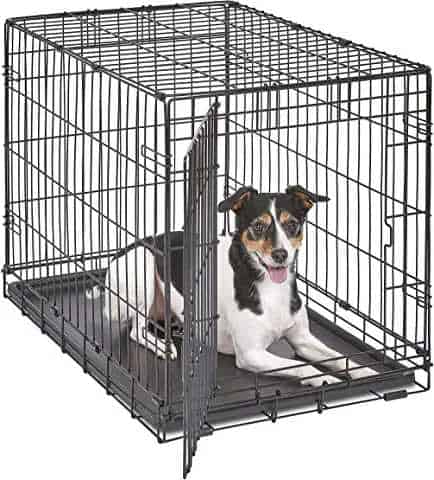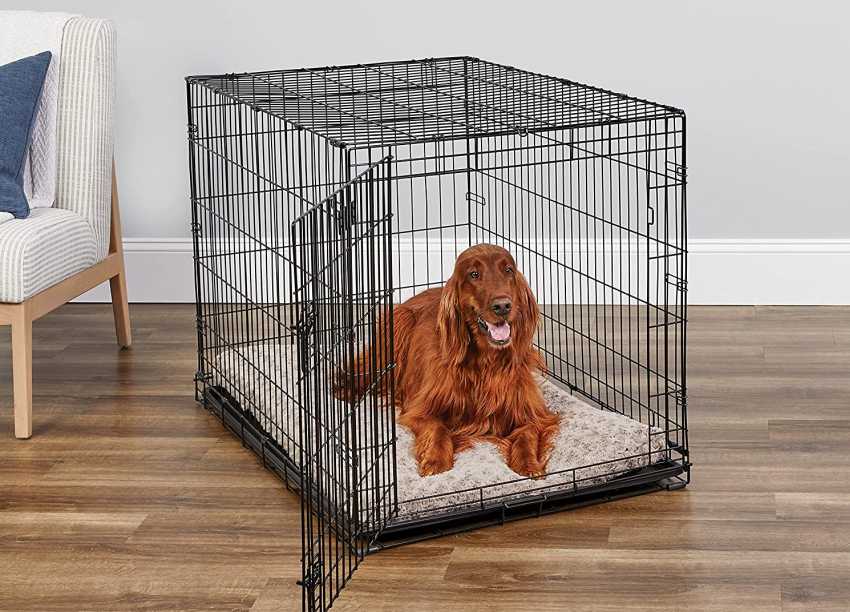If you want a well-mannered dog that doesn’t destroy stuff and goes to the toilet outdoors, you first have to establish yourself as the pack leader and secondly, learn how to crate train a dog. Because dogs are born trained, and just like children, you have to teach and train your dog. Among countless other things, crate training is one of the most important things you should train your dog for.
While many people (mostly those who have never owned a dog) relate crates with being “caged up,” dogs prefer being in small, secure, confined spaces. Crate training broadly means getting your dog used to being in a crate or cage. Crate training is important because if trained properly, your dog feels safe and comfortable in the crate.
Crate training makes use of the dog’s natural inclinations to seek out a comfortable, calm, and safe location. Crate training not only ensures the safety of your dog but also keeps it away from chewing on household items or causing other damage. Crates are also a secure method of transporting your dog in the car. If your dog is crate trained, your journey with your pet will be a lot more comfortable and smooth.
Now that we have discussed the importance of learning how to crate train a dog, let’s talk about some actual training tips. To make it easy for you to learn, I am sharing step by step guide to crate training your dog.

8 Step Guide on How to Crate Train a Dog
Step 1: Selecting the Best Crate for Your Dog
Choosing a suitable crate for your dog is the first step toward effective crate training.
Crates are classified into two types:
- Plastic crates or flight kennels
- Great for airline travel
- Good for dogs that prefer to sleep in the dark
- Easy to clean up
- Wire crates
- Often collapsible for easy storage
- It May contain a separator to divide the front and back of the crate
- Durable and long-lasting
Step 2: Create the Right Attitude
Put whatever apprehensions you have about putting your dog in a crate to the side. Dogs are highly sensitive to the emotions of their owners, so if you’re worried about crate training your dog, your dog will also be worried.
Don’t start training until you’re in a peaceful, comfortable, and pleasant state of mind.
Step 3: Decide how your dog will feel most at ease
To create a comfortable environment, some people utilize dog mats or towels, although this isn’t always a good option. It’s trial and error all over again. Depending on the breed of dog you have, it may tear up a dog bed or pee on it. It’s quite possible that your dog snoozes on the crate itself. Dogs generally prefer hard surfaces. In short, you’ll get to know your dog’s preference after trying different things.
Step 4: Introduce Your Dog to its Crate
After introducing your dog to the crate, the next step in crate training a puppy is to increase the time spent in the crate. Get your dog a special chew bone, set up its crate next to your chair, and fill it with toys. Sit, watch your dog or do something else while sitting in your chair. Your puppy should be crated next to you for an hour or two. This will give your dog a sense of security.
Don’t keep your dog in the crate for too long. Your dog needs to go out to play, eat, and relieve itself. Dogs don’t want to contaminate their sleeping areas, but if they stay too long without going for a stroll, they may do so.
Step 5: Enjoy Crate Games
Once your puppy has gone in the crate a few times, it’s time to play a game. Allow your puppy to see you with tasty goodies or entertaining toys before tossing them into the kennel. When the puppy runs into the box to fetch treats, praise it. Restart the game when your puppy returns to you. Perform this exercise five times in succession, several times each day.
Step 6: Make it Reflexive
After a few days of putting treats into the puppy’s kennel, you can begin training your dog to enter the box on its own. Your puppy should already be running inside the crate to gather treats when you toss food in before you begin this stage. At this stage, you can give a command to your dog to “get in.” Reward and encourage your dog every time it follows your command.
Practice for a minimum of ten sessions or until your dog shows no hesitation to enter the crate to earn the treat. Then you’ll want to make it a little more difficult.
Step 7: Putting Your Dog’s Food in the Crate
Begin feeding your dog its usual meals near the crate after introduction. This will help you form a positive association with the crate. If your dog enters the crate easily, place the food bowl in the rear. If your dog still doesn’t go into the crate, only put the dish inside as far as it’ll go without being afraid or worried. Place the dish a bit further back in the crate each time you feed your dog.
Step 8: Be Patient
Patience and perseverance are necessary if you want to crate train your dog. It can take anywhere from 6 days to six months to crate train a puppy. Because dogs aren’t linear learners, there will be ups and downs, but eventually, you will succeed. If you feel disappointed, remember the reason you started training your dog.
During the process, you may face some issues. They usually arise due to the impatient behavior of the pet or the owner. Be patient and never give up, and you’ll train your dog to be the pet you always wanted.
The key is to be consistent. Regular daily training will get quick and long-lasting results. Trying to train a puppy to do anything requires consistent and persistent training sessions and a daily basis. You will not get lasting results if you only spend a couple of sessions a week or only train your dog on the weekends.
Training Tip: Establish a daily Crate Training Schedule – and stick to it!

How to Crate Train an Older Dog
In response to a number of questions from people who have an older dog that needs to be crate trained. More often than not, this is because of a change in circumstances of the owner or dog’s living situation.
For example, the owner moves from a house with a yard to an apartment, and the dog needs to be confined to a crate during the rehoming process. Another reason for crate training an older dog is when some long-distance travel is required.
In essence, there is nothing you need to do differently to crate train an older dog. The same key things apply – patients, persistence, and consistency.
Remember that you are training a dog to do things differently, changing lifelong habits takes time, and cannot be hurried.
In my experience crate training at night is a good way to introduce an older dog to their crate. The first goal is to simply get the dog to enter the crate of its own accord. The end goal would be for the dog to sleep in the crate overnight without issue.
How Many Hours a Day Should a Dog be in a Crate?
This is a great question. But, is also a question that is not easily answered.
Why? Well, it depends on so many things.
However, I would argue that the less time in a crate the better. Dogs need daily exercise, and dogs need the freedom to go to the bathroom when they have the urge – dogs do not defecate where they sleep – unless their owner has given them no choice!
In my opinion, a dog should only be in a crate overnight and then at times during the day when they are being disciplined or it is for their safety.
That said, I know of a situation whereby the owner of a golden labrador takes it for an hour walk every morning, then by around 8:00 am the dog is in the crate for the rest of the day till around 3:30 pm (although, sometimes its as late at 6:00 pm)- while the owner is at work.
On returning home, the owner lets the dog roam in the yard for an hour or so. And while the dog sleeps in the crate at night, the door is open.
Prior to locking the dog in the crate each day the dog experienced separation anxiety and destroyed a lot of stuff around the house. In this situation, the dog is healthy and happy and does not appear to suffer from this arrangement.
But I also know of another situation whereby the scenario is similar but the effect on the dog, in my opinion, is not ideal.
In this situation, the dog gets to walk some mornings, depending on the weather and the mood of the owner. He does get to toilet in the yard first thing in the morning but within an hour is back to the crate for the rest of the day.
The only way the owner gets the dog into the crate is the dog’s first meal of the day. Then the dog howls all day long. The dog is aggressive and uncontrollable, and not a dog I’d want around children.
The SPCA is monitoring the situation and hopefully, for the dog’s sake, a solution will be found soon.
In my opinion, if you own a dog and work all day, you should find a better option than locking it up in a crate all day. Arrange a dog walker, or take it to a dog daycare center so that it gets exercise and socializes with other dogs.
I will write another article on how to crate train a dog with separation anxiety at a later date because crate training a dog with separation anxiety requires a slightly different approach. So look out for that article.
Recent Posts
Key Highlights Hanging Tongue Syndrome is a condition in which a dog's tongue hangs out of their mouth, and it can be caused by genetic predispositions or severe dental disease. Dogs with this...
Key Highlights Dogs stick out their tongues for various reasons, including relaxation, panting to cool down, the use of medications, and hanging tongue syndrome. Hanging Tongue Syndrome is a...

